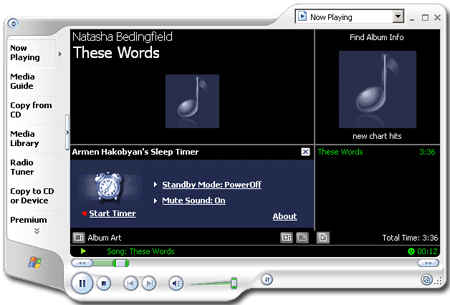In this article, you will see my implementation which is similar to the TV's Sleep timer function. You will also see my Media Player plug-in which instead of turning Media Player off after the specified interval of time turns the PC off when the media ends.

Introduction
Recently, I found Media Player Sleep Timer in the Media Player Bonus Pack for Windows XP (or Power Toys or something like that). That plug-in is similar to the TV's Sleep timer function, which turns TV off after some interval, set by user - so it closes Media Player after the interval set. And I decided to implement a similar functionality for my PC - and wrote this Media Player plug-in which instead of turning Media Player off after the specified interval of time turns the PC off when the media ends. For example, you can load playlist with your favorite music, or play a DVD movie, etc., start this plug-in, and go to bed. After the movie (music file, playlist, etc.) ends, your PC either shuts down or logs off or hibernates/suspends, depending on your settings. It can also mute sound during shutdown operation. Frankly speaking, I don't know if it really is a timer at all, but no matter.
Implementation
If you are unfamiliar to Media Player plug-ins, then you should read the Microsoft Windows Media Player SDK Help first. In short, the Windows Media Player plug-ins are COM objects, allowing to extend its architecture. This ATL DLL contains only two types of plug-ins: the user interface plug-in and the background plug-in. The user interface plug-in creates a window in the Media Player Settings area of the full mode player, allowing the user to manage global settings - so it tells to the background plug-in (which is running constantly after the Player starts) whether to listen to the Media Player events or not, and sets the type of Standby Mode (PowerOff/LogOff/Hibernate/Suspend) and Mute Sound (On/Off). The background plug-in runs in the background (as it follows from its name), and listens to the Media Player events. When the media end event is triggered, it mutes sound and shuts down the PC if the user enabled these features through the UI plug-in.
The main problem was communication between these two plug-ins - Media Player does not give you the interface pointers to the plug-in instances. But I remembered that both plug-ins are in the same DLL, and the Player instance is limited to a single one, so just created the shared data segment. The UI plug-in just sets the mode variables in the shared section, and the background plug-in just reads them. That's all.
The setup inf file is also included in the project. You can build a small setup EXE with the IExpress utility. IExpress is included with Microsoft Internet Explorer Administration Kit - it allows to build small and fast setup packages.

Program Setup
After running the setup.exe or just registering the plug-in DLL (with regsvr32.exe), open Media Player. From the Tools menu, select Options. After the Options property sheet is displayed, navigate to the Plug-Ins tab, select Background in the list of the plug-ins, and check Armen Hakobyan's Background Sleep Timer. This will load the background plug-in in case it is not loaded automatically. Then, to display the UI plug-in, switch Media Player to full mode, go to the View menu, and from its Plug-Ins submenu, select Armen Hakobyan's Sleep Timer.
Program Requirements
Project Dependencies
Acknowledgements
History
- 18th May, 2005
- 23rd May, 2005
- Removed unused member variable of
CToolTipCtrl type from the CUIForm class - Removed unused
string buffer for loading tooltip text in the CWmpHyperLinkImpl class' Init function - Fixed bug in
EnableShutdownTokenPrivilege function - the second pointer parameter was referenced in the function body even if NULL was passed instead - Fixed bug in
MuteSound function which always muted sound regardless of the user settings, and also changed it to return previous sound state (to restore later if needed) - Added new registry map macros
- Replaced damaged setup executable
